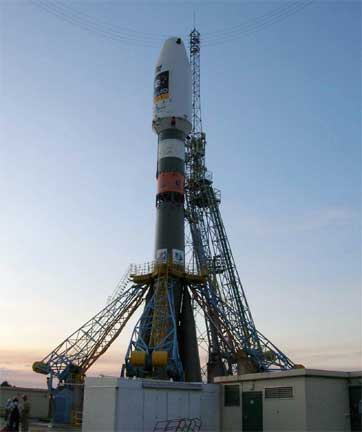
The completed Soyuz is shown in its launch-ready configuration at the Spaceport following the roll-back of its mobile service gantry.
Arianespace’s newest member of its launcher family has made a debut appearance in French Guiana as the initial Soyuz to be operated from the Spaceport was revealed in its entirety for the first time during final preparations for an October 20 liftoff.
This milestone Soyuz was seen in its fully-assembled configuration as the mobile service gantry, in which the launcher’s final integration had been completed, was rolled back during activities performed at the weekend.
The gantry roll-back is among the final validation steps in preparing the historic number one Soyuz at French Guiana for an October 20 liftoff on a mission to deploy its payload of two Galileo navigation satellites into a 23,222 km. orbit, inclined 54.7 degrees.
Soyuz’ gantry is one of the most visible changes in Spaceport operations when compared to the long-existing horizontal processing flow used for this workhorse medium-lift launcher, which ushered in the space age and currently is operated at Baikonur Cosmodrome in Kazakhstan and Plesetsk Cosmodrome in Russia.
With a height of 52 meters to the top of its curved roof, the Spaceport’s purpose-built gantry allows payloads to be installed atop the Soyuz vehicle while in its vertical position, as is the practice with Western-built launchers, including Arianespace’s heavy-lift Ariane 5 and the new lightweight Vega.
Using this process, the basic three-stage Soyuz was transferred horizontally from the Spaceport’s MIK launcher integration building on Friday, October 14, and then raised to the vertical position on its massive concrete launch pad.
The mobile gantry then moved into position to protect the launcher, allowing the Soyuz’ upper composite, consisting of the launcher’s Fregat upper stage, the dual Galileo satellite payload and payload fairing, to be installed the same evening.
This was followed by a validation of the gantry’s rollback to its parked position some 80 meters from the launch pad on October 15, exposing the completed Soyuz for the first time. Other activity included testing of telemetry links with the Soyuz, followed by the gantry’s return to the launch pad where it will remain in position to protect Soyuz until one hour before liftoff on October 20.
The two Galileo satellites to be deployed by Soyuz on its 3-hr. 49-min. flight maiden flight from French Guiana have a launch mass of approximately 700 kg. each, and were built in a consortium led by EADS Astrium.
These In-Orbit Validation (IOV) satellites, along with two other IOV spacecraft to be lofted by Soyuz in 2012, will form the operational nucleus of Europe’s full 30-satellite Galileo navigation constellation. Developed in a collaboration of the European Space Agency and European Union, the Galileo network is designed to provide highly accurate, guaranteed global positioning services, and was conceived to be interoperable with the U.S. Global Positioning System and Russia’s Glonass network.
With Soyuz’ upcoming introduction at French Guiana, Arianespace marks the next step in its launcher family expansion, as this vehicle joins the heavy-lift Ariane 5 in operations from French Guiana. Arianespace will complete the launcher family extension with the lightweight Vega vehicle, which is to complement Soyuz and Ariane 5 at the Spaceport beginning in 2012.
By operating this three-member family, Arianespace will be the world’s only services provider capable of launching all types of payloads to all orbits, from the smallest institutional and scientific spacecraft to the largest geostationary telecommunications platforms, along with clusters of satellites for constellations and resupply vessels to support the International Space Station.

